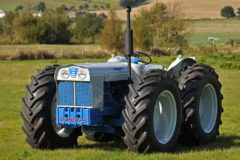Lucky Scania survivor!
Posted by Chris Graham on 13th March 2020
Although Jon and Jamie Holey’s restored 1987 Scania 142M had a relatively short working life, it was a far from easy one. Peter Simpson meets this lucky Scania survivor, and its enthusiastic owners.
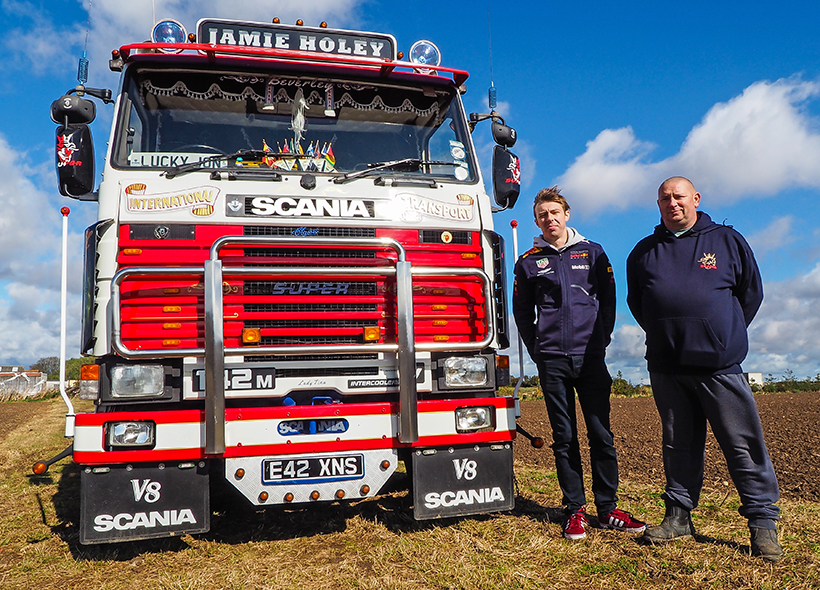
A lucky Scania survivor: Jamie and Jon Howie, father and son owners of this very smart, 1987 Scania 142M.
This month’s restoration story is slightly different from the usual Classic & Vintage Commercials main feature in that, rather than spotlighting a lorry that’s been restored relatively recently, we’re looking at one which has been with its current owner for nearly 20 years, though it had an unusually high number of working owners prior to that.
Bought for £1,000 and returned to the road within two months, it’s been restored twice in the past two decades and, although very much a privately-owned vehicle, it’s often used to pull a load at the hands of an owner who is far happier driving his lorry, than sitting in it at a show.
Jon Holey is one of those people who, if cut, would probably bleed engine oil or transmission fluid, rather than blood! Trucks have been part of his life since his very early teens, and he freely admits to having been a “bad one at school” – to the extent that attendance was an issue. However, a family friend named David Hodges was involved with haulage from Hull Docks, and a unofficial ‘deal’ was brokered with parents, school and David.
Unofficial driving!
If John, then aged about 14, went to school, he could spend weekends working with David, including totally unofficial, off-road, lorry-driving around Hull Docks. This worked, though in time – and perhaps inevitably – the time spent with David increased slightly, while the time at school reduced; a situation everyone involved accepted as practical learning, which was clearly going to be a lot more use than sitting in a classroom. A little later, it was also David that provided Jon’s introduction to lorry restoration in general, and Scanias in particular, but we’ll come back to that in a moment.
Jon’s full-time driving career started on crawlers, with Tarmac Construction, after which he graduated to 25- and then 48-tonne dump-trucks. He subsequently took his HGV test, and went to work for David Harrison on potato haulage from Lincolnshire. This work was, quite literally, all over the country, with destinations as far afield as Weston Super Mare, Anglesey and Couper in central Scotland. He subsequently moved to a firm in Leeds doing similar work, then to North East Truck and Van, on low-loader work – again travelling nationwide. Nowadays, he has sort-of come full circle, as his ‘paid’ job is digger-driving though, as we’ll see later, he still does plenty of LGV driving…
As noted a moment ago, Jon’s first lorry for restoration came from his first ‘employer’, Dave Hodges. It was a Scania 141 which had been standing for many years. Jamie bought it very cheaply, but it turned out to be too far gone for a sensible renovation, and was subsequently sold to Ashley Pearce and broken for spares. However, had John not owned the 141 first, he would probably never have bought the 1987 142M featured here, because he came across it while looking for spares for the 141…
Scottish routes
As its registration implies, E42 XNS was new in Scotland, and seems to have spent most of its working life north of the border. There are a few gaps in its known history, but it’s known to have started its working life with a bulker trailer on one of the Scottish islands. Unfortunately, it proved unsuitable for ‘island life’, being too large and expensive to run so, after just three months, it moved on to Grayline, where it worked on general haulage; particularly concrete beams and fridge work. After this, it was bought by Thomas Finlay, who pulled for Charlie Meeks on refrigerator work, including regular trips to Germany.
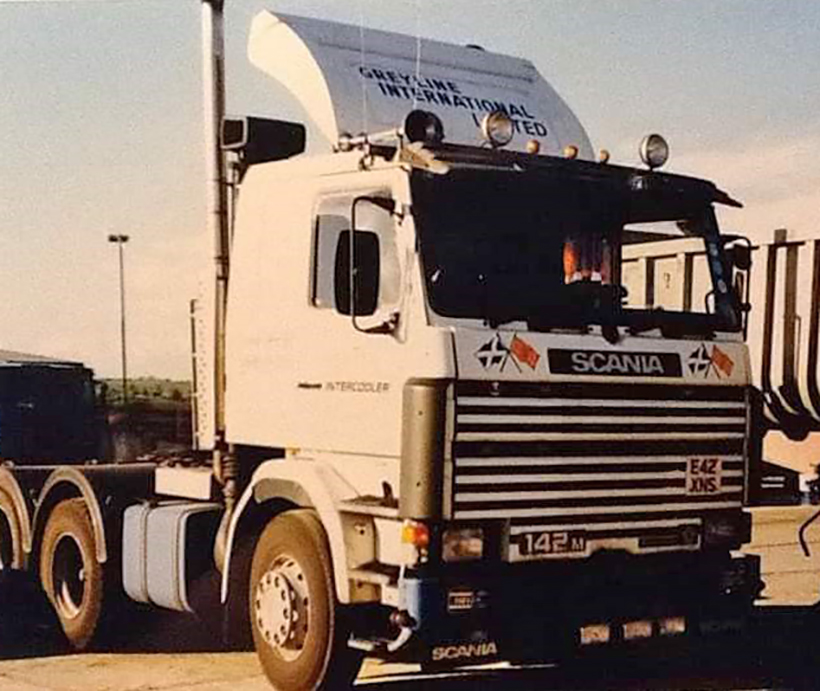
The 142M pictured while with its second owner, Grayline International.
Then it ‘disappeared’ for a time, before reappearing, still in Scotland, on container work, with Bingham of Greenock. Another ‘disappearance’ followed, before it re-emerged, still on container work, but now at almost the opposite end of country – in Southampton – with Germany again a regular destination. Its active life here ended when it was ‘side-swiped’, causing damage to the cab offside, damage that was repaired roughly using steel sheet.
After this, the Scania moved to the New Forest, where repair and use to transport polo horses was planned. But, for some reason, this never happened, and the Scania, still owned by the polo company, finished up parked up in a dealer’s yard near Southampton, from where Jon bought it.
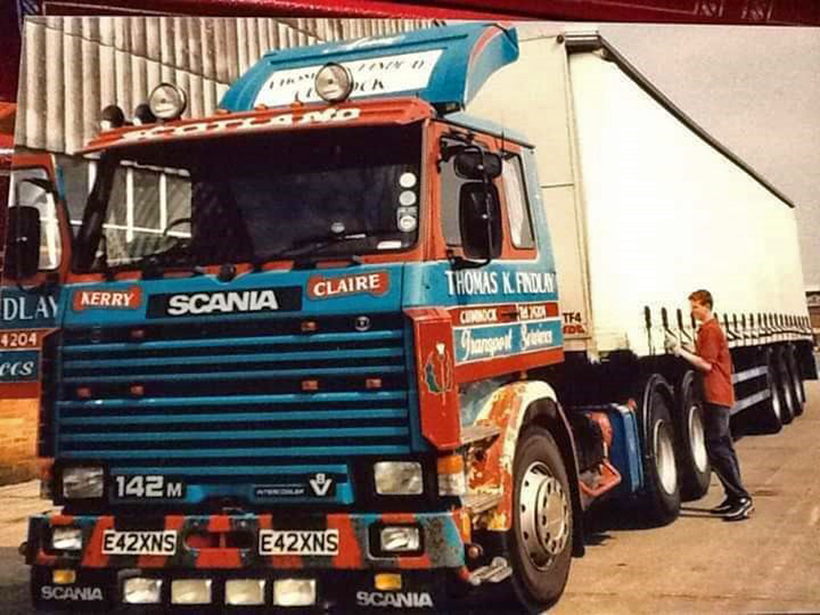
With Thomas K. Findlay, and a curtainsider trailer. Clearly a hard-working lorry!
Long trip home!
John came across the 142 while looking for a replacement cab for the 141 but, on seeing the 142M, he decided that this would probably be a better bet, so arranged to buy that instead. He subsequently got it started and drove it back to Hull, although the journey was far from trouble-free. At the junction between the M25 and M1 – which, as most readers will be very well aware, is a far-from-ideal place to experience mechanical problems – the Scania almost died.
At the time, Jon was unable to find the fault, so had little option but to limp on at speeds of 25-30mph, depending on road gradients etc. He’d plotted a series of ‘friendly yards’ on the way, into which he could pull for help if the problem got too severe. That, fortunately, didn’t happen but, nevertheless, the journey home still took nearly 10 hours, and Jon eventually arrived back in Hull at just after 3am…
Once back, it was actually Jon’s son Jamie – though only a boy at the time – who found the fault. There was a glass bowl-type fuel filter on the main fuel line but, because it had been painted over, it was far from obvious. Jamie scraped the paint off, dismantled the filter and found that it was badly clogged. The fuel line, too, was extensively silted up, leading to insufficient fuel passing for higher speeds. The filter internals were cleaned and renewed as required and, as an additional precaution, a one-way valve was added to the fuel line.
This is actually an appropriate place to bring Jamie into the story, as he has basically grown up with this lorry and, as he’s got older, has become more and more involved with it. So much so that the 142 is now, to all intents and purposes, owned jointly. In fact, following its most recent repaint, it now carries Jamie’s name.
Once the fuelling issue had been resolved, the remaining work needed was relatively straightforward so, returning the Scania to roadworthy condition took only two months. It was largely a case of cleaning-up, freeing-off and tidying-up, after which the lorry went straight through an LGV test.
Two restorations
Five years later, Jon decided to embark on a more extensive renovation. However, it nearly ended before it started, when a replacement cab he’d bought turned out to be twisted and of no use, other than as a parts donor. At this point, perhaps unsurprisingly, he lost interest in the project for a while, but rekindled his enthusiasm soon afterwards and found another replacement cab from a chap in Norfolk.
This was stripped to a bare shell, repaired as required and repainted, and renovated inside. Other work carried out at this stage included new brake shoes and drums, springs, shock absorbers and a chassis repaint. The cab was refinished in black, and the lorry returned to the road.
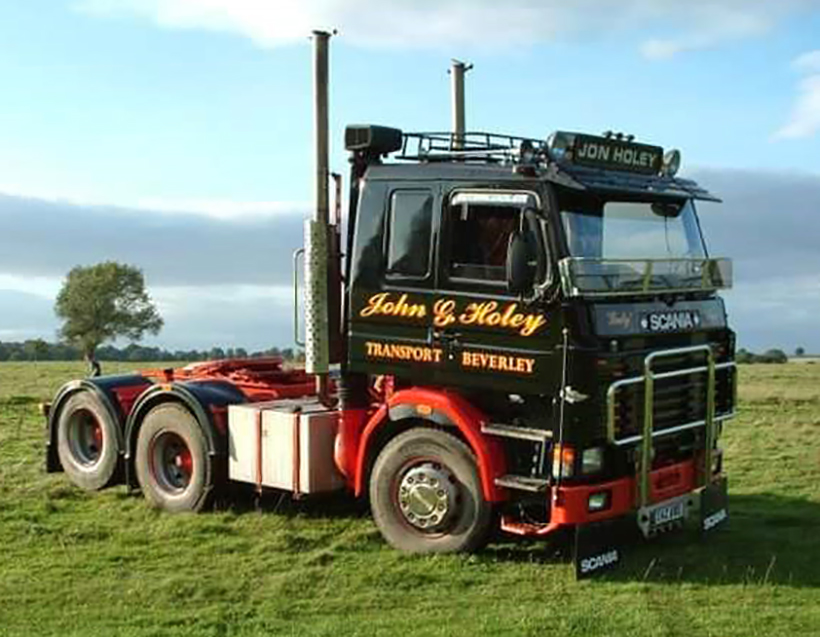
Following its first rebuild, here’s the 142M during its ‘black cab’ period. Jon’s name was spelt incorrectly on the cab side, but the job was too well done to change!
Then, in 2010-11, a much more comprehensive and thorough overhaul was carried out. However, although, genuine Scania parts were used, this ‘restoration’ – like so much else about this lorry – was done how Jon wanted it. Once again, the cab was the main focus; both doors were replaced with new, and the interior was gutted, with new parts replacing whatever needed to be changed.
Mechanical work undertaken at this stage included fitting new slack adjusters, together with a new radiator and intercooler. The wheels were replaced with genuine Scania items and the cab was repainted again, this time white, with Jon doing the preparation work himself but a friend (Carl) applied the top coat.
Mechanical matters
The Scania V8 engine and five-over-five gearbox have been cleaned up in John’s ownership, but no internal work has been needed or carried out. However, Jon understands that some engine work was undertaken ‘at the roadside, during one of the lorry’s working trips to Germany. The total mileage covered remains a complete unknown.
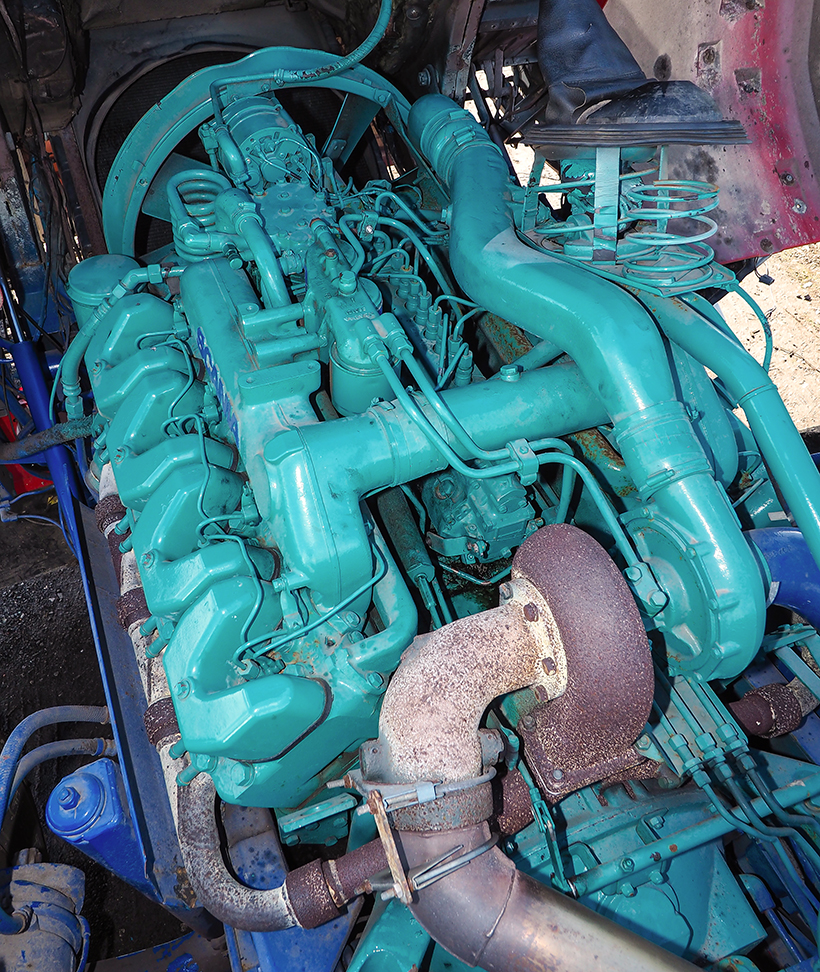
The Scania V8 engine has needed no attention in Jon and Jamie’s ownership, but is reputed to have once been part-rebuilt at the roadside in Germany.
It’s common for the restoration part of stories like this to conclude with a list of shows that the owner has wither been to, or is planning to attend. That, though, is another aspect of this story that’s slightly different; while Jon has, in the past, attended several shows – and is, apparently, known by quite a lot of people – he’s recently become somewhat disillusioned with this aspect of the hobby.
He dislikes what he sees as an emphasis on perfection, and the increasing number of ‘chequebook’ restorations where the owner’s only significant contribution is to pay a restorer’s bills. “I pay for everything on my lorries myself and, if I can’t afford to replace something, I leave it on or get by in some other way. At the end of the day it’s my hobby and, if the lorry is here, I can come and see it whenever I like,” he told me.
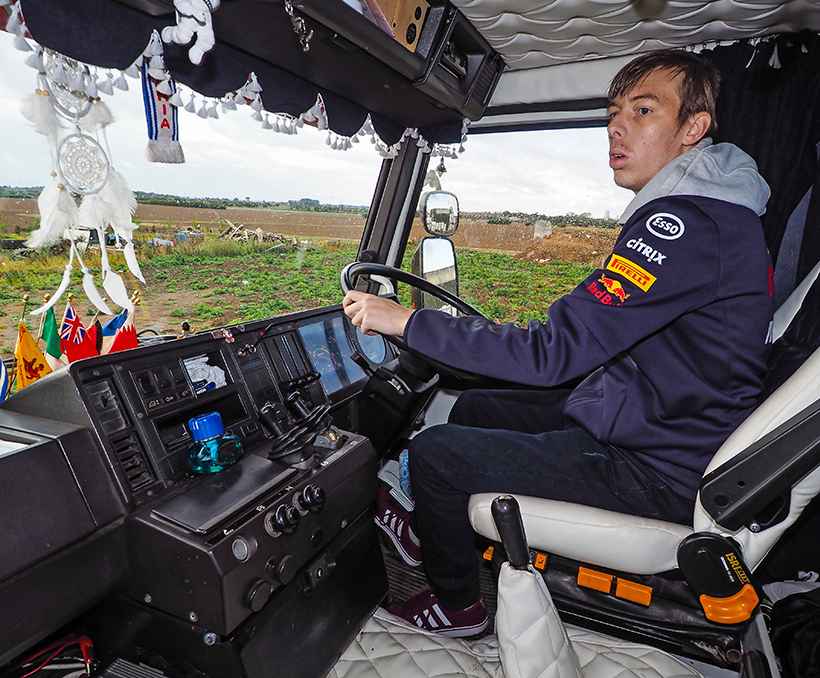
Classic, retro-eighties continental driving cab!
So, if it’s not owned for showing, then what is it owned for? Well basically, Jon just likes driving it. Over the past 20 years, he’s also become something of a ‘go to’ person for parts within the Scania community – though he stresses that this is by no stretch of the imagination a commercial operation, and he certainly doesn’t seek to profit from the parts he buys and passes on. Rather, it’s a case of buying complete lorries for breaking, using some of the parts himself, and selling the rest to recoup some of the cost of the hobby overall. And, of course, a fine Scania 142M – and a low-loader trailer – is just the right kit with which to collect large items from anywhere in the UK!
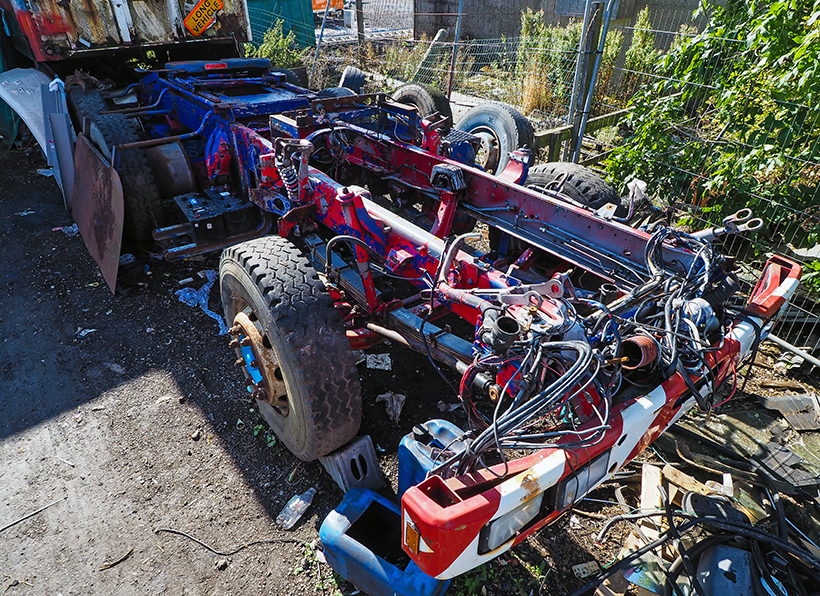
Another project or parts? Though Jon is a keen preservationist, he fully recognises that some old lorries are better used as parts suppliers to keep others going…
A few others…
In the circumstances, it’s perhaps inevitable that other lorries are waiting in the wings. The second one is actually an early 142 – a 1984(A) tag lift. Jon bought it two years ago, but has only collected it relatively recently. He also recently bought three more 142Ms, that had been operated by Southampton-based Waters Brothers, Phil Waters being described as ‘a friend.’
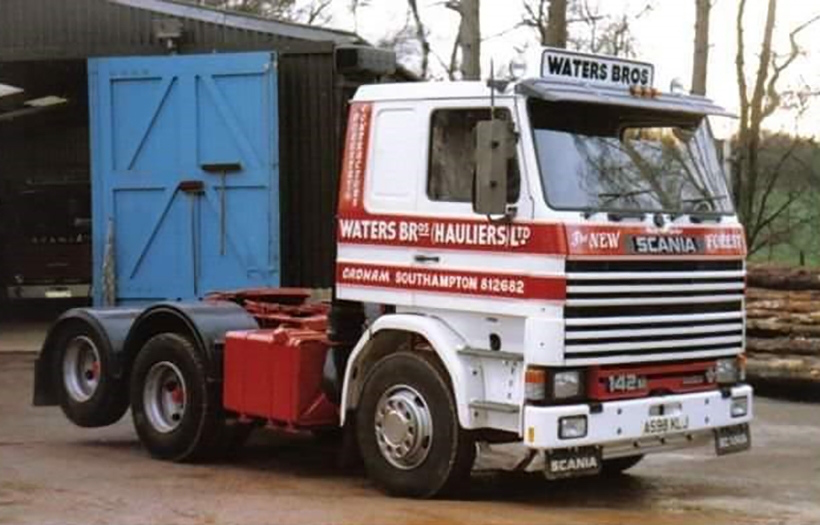
The next project; a 1984 142 tag axle, obtained from Waters of Southampton. A replacement cab has been earmarked…
One of these has already been dismantled for spares, and the plan is to build one good lorry from the remaining two and, “if there are enough parts left over, we may well put them together to build another one,” Jon added. One of the cabs from this trio (a 1985/B) has, however, been earmarked for the 1984 tag lift. Also awaiting restoration are two trailers; a 1971 Skeletal and a 40ft curtainsider.
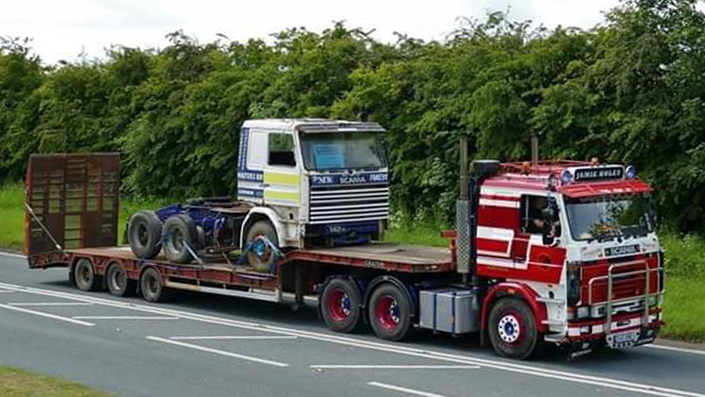
Dragging another one back for restoration; Jon and Jamie love using the lorry in this way though, unfortunately, they don’t get to do it as often as they’d like.
So there we are. Unlike with many lorries which owe their survival into preservation to a relatively easy working life with a relatively small number of owners, this one had a working life which, though relatively short, was certainly an extremely arduous one, with several different owners and including lots of continental work.
Those days are now behind it, and this 33-year-old lorry has been preserved for one-and-a-half times as long as it was working. However, it’s no preserved ‘pet’, that simply gets trundled out to shows and for the odd road-run; this is a lorry that’s owned primarily for driving enjoyment and, while most of that use is – unsurprisingly – unladen, one gets the clear impression that the thing this father and son team enjoy more than anything else, is using it with a load on the back. We love it!
You can subscribe to Classic & Vintage Commercials by clicking here



